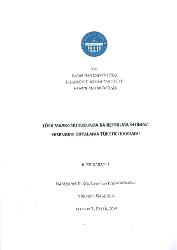| dc.contributor.advisor | Hamamcıoğlu, Esra | en_US |
| dc.contributor.author | Karayel, Berk | |
| dc.date.accessioned | 2020-02-20T14:35:58Z | |
| dc.date.available | 2020-02-20T14:35:58Z | |
| dc.date.issued | 2019 | |
| dc.identifier.uri | https://hdl.handle.net/20.500.12469/2785 | |
| dc.description.abstract | Günümüzde şirketlerin artan markalaşma faaliyetleriyle birlikte marka ve markanın sağladığı haklar birçok uyuşmazlığa konu olmaktadır. Marka hakkı ihlalinin sıklıkla karıştırılma ihtimalinin ortaya çıkması nedeniyle gerçekleştiği de bilinmektedir. Mal veya hizmetin hitap ettiği tüketici kitlesinin algısını etkilemeye yönelik marka tescilleriyle birlikte karışıklığa yol açan taraf, önceki marka sahibinin itibarından yararlanmakta ve bu durumdan kazanç elde etmektedir. Karıştırılma ihtimalinin ortaya konulabilmesi için doktrinde ve uygulamada bazı ölçüt ve unsurların varlığı kabul edilmektedir. Teknolojik gelişmeler ve teknolojiye ulaşım imkanlarının hızla artması nedeniyle karıştırılma ihtimalinin bir ölçütü olan ortalama tüketici kavramı da bu süreç içinde gelişmekte ve değişmektedir. Bu çalışmada, karıştırılma ihtimali ölçütleri ve unsurlarıyla açıklanmış, yargı kararları da kullanılarak karıştırılma ihtimalinin nasıl tespit edilebileceği anlatılmıştır. Karıştırılma ihtimalinin unsurlarından biri ve kanımızca en önemlisi olan ortalama tüketici kavramı da hem doktrin görüşleri hem de yargı kararları ışığında açıklanmaya çalışılmıştır. Bu çalışmanın ana amacı, marka hukuku ekseninde karıştırılma ihtimali kavramının açıklığa kavuşturulması ve ortalama tüketici kavramının bu kapsamda nasıl tespit edilmesi gerektiğine dair görüşlerin ortaya konulmasıdır. | en_US |
| dc.description.abstract | Today, with the increasing branding activities of companies, trademarks and the rights
provided by trademarks now become subject to many disputes. It is also known that the
trademark right violations often happen because of the likelihood of confusion
occurrences. The party that leads to confusion with the trademark registrations, which are
intended to influence the perception of the consumer audience that the goods or services
appeal to, takes advantage of the reputation of the previous brand owner and benefits
from this situation.
In order to present the likelihood of confusion, some criteria and elements are accepted
both in the doctrine and in practice. The average consumer concept, which is the criterion
for the possibility of confusion, is also developing and changing in this process due to
technological developments and the rapid increase in the chances of access to technology.
In this study, the likelihood of confusion is explained with its criteria and elements, and
also by using judicial decisions, how to determine the possibility of confusion is
expounded. The concept of average consumer, which is one of the elements of confusion
and the most important one in our opinion, has also been tried to be explained in light of
both doctrine opinions and judicial decisions. The main purpose of this study is to clarify
the possibility of confusion concept in trademark law and to put forward the opinions
about how the concept of average consumer should be determined in this context. | en_US |
| dc.language.iso | tur | en_US |
| dc.publisher | Kadir Has Üniversitesi | en_US |
| dc.rights | info:eu-repo/semantics/openAccess | en_US |
| dc.subject | Marka | en_US |
| dc.subject | Marka Hukuku | en_US |
| dc.subject | Karıştırılma İhtimali | en_US |
| dc.subject | Ortalama Tüketici Kavramı | en_US |
| dc.subject | Trademark | en_US |
| dc.subject | Trademark Law | en_US |
| dc.subject | Likelihood of confusion | en_US |
| dc.subject | Average consumer | en_US |
| dc.title | Türk marka hukukunda karıştırılma ihtimali ekseninde ortalama tüketici kavramı | en_US |
| dc.type | masterThesis | en_US |
| dc.department | Enstitüler, Lisansüstü Eğitim Enstitüsü, Hukuk Ana Bilim Dalı | en_US |
| dc.relation.publicationcategory | Tez | en_US |
| dc.identifier.yoktezid | 597752 | en_US |
















